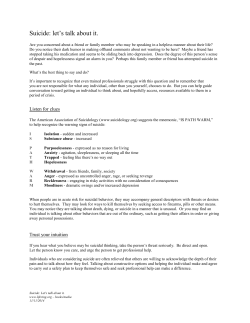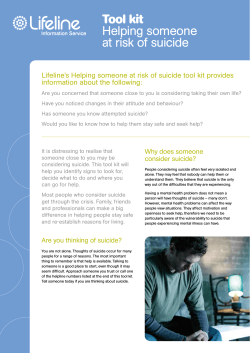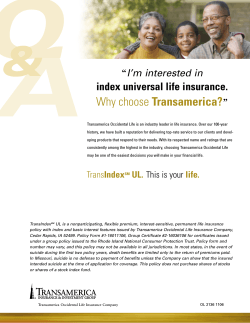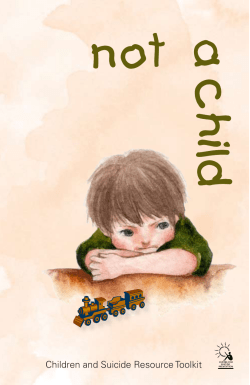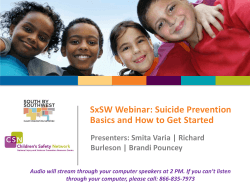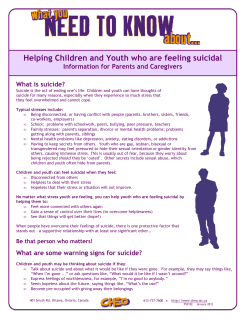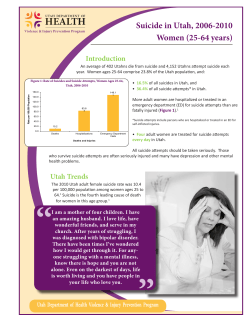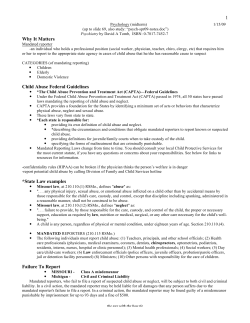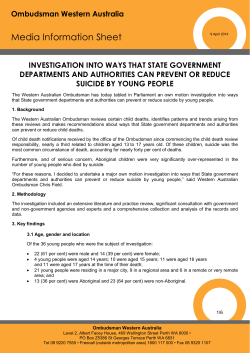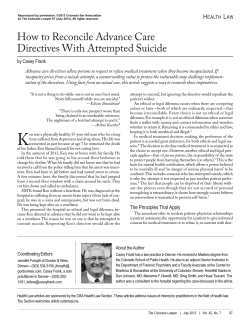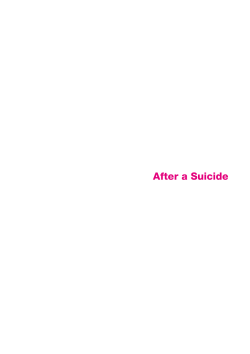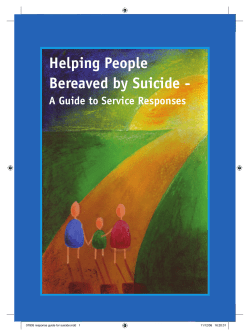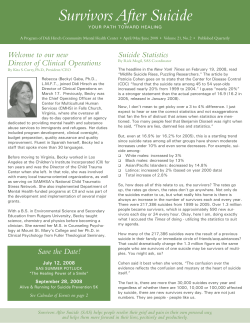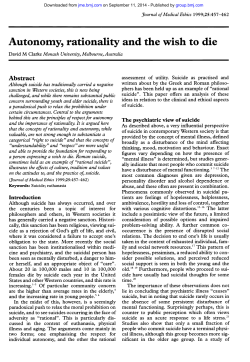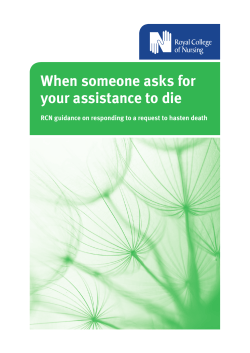
Suicide and the Cancer Patient
Suicide and the Cancer Patient Presented by Murray Hillier Coordinator Empowerment-Education Centre Providence Continuing Care Centre Mental Health Services Suicide Outline Why are we talking about this? Stats and Study Definition Myths and Facts Attitude…yours What to look for What you can do…assessment tools Why are we talking about this? Statistics: Region: Canada Year: 2003 Population: 31,669,200 Continued… Reported Suicides: 3,765 Unreported suicides: 5% to 25% more suicides Non-fatal suicidal behaviours: 40 – 100 times Number of people affected: Each suicidal behaviour may affect a few or a very large number People with thoughts of suicide: 1.9 million Suicide Statistics Currently there are slightly more than 30,000 suicides annually (83 suicides per day; or 1 suicide every 17 minutes) with 12 of every 100,000 North Americans killing themselves. Males complete suicide at a rate four times that of females. Rates of suicide are highest among the elderly (age 65 and over) Suicide statistics con’t… 25% of all cancer patients experience severe depressive symptoms with 6% having a diagnosis of major depression. (Bukberg J., Penman D., Holland J.) The suicide risk following a cancer diagnosis was highest in the first 3 months for men and between months 3 and 12 for women. Overdose of analgesic and sedatives are the most common method of suicide by cancer patients. Suicide statistics con’t… Most cancer suicides occur at home. Relative risk of suicide in cancer patients is twice that of the general public. Desire for Death in the Terminally Ill Study: By Hm Chochinov, K.G. Wilson, M. Enns, N. Mowchun, S. Lander, M. Levitt and J.J. Clinch Department of Psychiatry, University of Manitoba, Winnipeg, Canada (1995) Con’t… Objective: To investigate the prevalence of the desire for death in terminally ill patients and the stability of this desire over time. Con’t… Method: 200 terminally ill inpatients given interviews that assessed their desire for death – evaluating them for depressive episodes Each patient also completed a short form of Beck Depression inventory, providing ratings of pain and social support. Patients who expressed desire for death received follow-up interviews. Con’t… Results: 44.5% reported occasional wishes death would be soon. 8.5% had serious and pervasive desire to die. Desire for death was correlated with ratings of pain and low family support. Prevalence of diagnosed depressive syndromes was 58.8% among patients with a desire to die. Con’t… Conclusion: The desire for death is closely associated with Clinical Depression. Potentially treatable Decreases over time Suicide and Parasuicide Definition of the World Health Organization: “A suicidal act is the self-inflicting of injury with varying degrees of lethal intent and awareness of motive.” “Parasuicide” is an act of deliberate selfharm not resulting in death. Suicide Methods: Gun, hanging, carbon monixide, drugs. Means of suicide precipitous. Associated with ill heath and depression in both males and females 77% psychotic thinking Attitude to self, family and staff negative Done when alone Parasuicide Method: Minor tranquilizers, wrist cutting. Means of suicide are slow. Associated mostly with marital, financial and employment problems. 31% psychotic Rarely negative in all three areas of self, family and staff Done when in the presence of another Myths and Facts Myth: People who talk about it will not commit suicide. One does not need to take a suicide threat seriously. Fact: Most people communicate their intent, verbally, in writing, through art, with behaviours Con’t… Myth: People who are really serious about suicide give no clues Fact: Many people communicate warnings of their intent by such things as tidying up their affairs, giving away possessions, and being preoccupied with death Con’t… Myth: It is harmful to discuss the subject of suicide with clients Fact: Most suicidal persons need acceptance and emotional support; discussing the topic demonstrates interest and concern Con’t… Myth: Young children never commit suicide Fact: Suicide can occur in children as young as age 4 Con’t… Myth: When people show signs of an improved mood, the threat of suicide is over Fact: Depressed people often show improved moods, attitude and behaviours before their deaths because the decision to commit suicide has been made Attitudes Do you agree or disagree with the following 3 statements? 1. Suicide is wrong. 2. People have a right to suicide. 3. Persons who die by suicide are responsible for their actions. Attitudes con’t Our attitudes are formed by the following: Personal values and beliefs Past experiences Spiritual or religious beliefs Fears Attitudes con’t… Not having an attitude or opinion about suicide is an attitude. If you are aware of your attitude, it can either work for you in an intervention, or you may have to be cautious to separate your own opinions in order to complete an assessment and take action. General Risk Factors History of mental health issues especially depression Family history of suicide History of suicide attempts Substance abuse Recent death of friend or spouse Little or no social support Age, sex and race Occupation Cancer specific risk factors A diagnosis of oral, throat or lung cancer (often associated with heavy alcohol and tobacco use) Advance stage of disease and poor prognosis Confusion/delirium Poorly controlled pain Con’t… Physical impairments such as: Loss of mobility Loss of bowel and bladder control Amputation Loss of eyesight or hearing Paralysis Inability to eat or swallow Exhaustion Protective factors Children Pets Spouse Religion What to do Observe behaviours: Crying Emotional outbursts Alcohol/drug misuse Recklessness Fighting/law breaking Withdrawal Dropping out Putting affairs in order What to do con’t.. Listen for thoughts: Escape No future Guilty Alone Damaged Helpless Preoccupied Talk of suicide or death Planning for suicide What to do con’t… Sense feelings: Desperate Angry Sad Ashamed Worthless Lonely Disconnected Hopeless What to do con’t… Ask about physical changes: Lack of interest/pleasure in all things Lack of physical energy Disturbed sleep Change/loss of sexual interest Change/loss of appetite, weight Physical health complaints Suicide Assessment Tool/Guide Factors associated with increased risk of suicide = “SADPERSONS” Sex: Male = 1 pt., Female = 0 Age: < 19 y.o. and > 45 y.o. =1 pt. Depression: if present = 1 pt. Previous Attempt: 1 pt. Ethanol Abuse: 1 pt. Rational thinking loss: if present 1 pt. Con’t… Social support lacking: 1 pt. Organized plan: 1 pt. No spouse-single, divorced or widowed: 1 pt. Sickness: i.e. cancer = 1 pt. Other Minor Factors: genetic, race, geography, season, occupation Con’t… Score: 4 – close follow-up >5 – consider hospitalization Internet Resources American Association of Suicidology (AAS) www.suicidology.org American Foundation for Suicide Prevention www.afsp.org Canadian Association for Suicide Prevention www.suicideprevention.ca/ Suicide Prevention Advocacy Network www.spanusa.org Suicide Prevention Australia (SPA) www.suicidepreventionaust.org Library and Resource Groups Centre for Suicide Prevention (CSP) www.suicideinfo.ca/ Centre de Recherche et d’intervention sur le suicide et l’euthanasie www.crise.ca/fr/index.asp Suicide Prevention Resource Center (SPRC) www.sprc.org Suicide Research and Prevention Unit www.med.uio.no/ipsy/ssff/hovedengelsk.htm
© Copyright 2025

